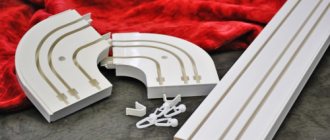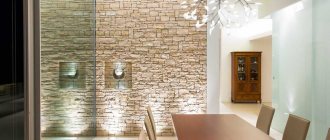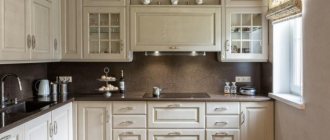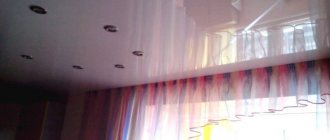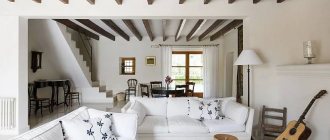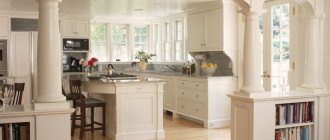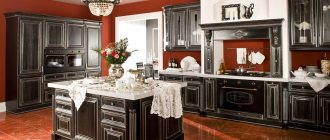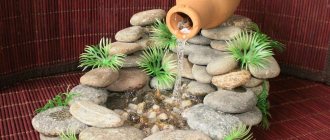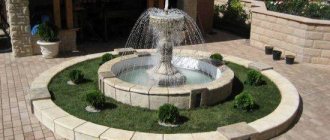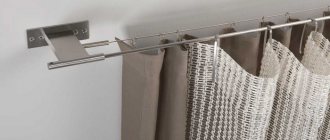A beamed ceiling brings a feeling of homeliness and warmth to the interior of living spaces. Regardless of whether the beams are structural features of the room or serve a purely decorative function, the design of such a space is transformed. A ceiling with beams made in colors contrasting with the entire surface of the ceiling will attract attention and create a special optical effect of the interior. But even ceiling elements painted the same tone as the ceiling will not go unnoticed. Thanks to their structure and distinctive texture, ceiling beams made of wood or other materials become an outstanding element of any interior.
The presence of beams on the ceiling can be caused by various reasons:
- in private urban or suburban houses, beams are an integral part of the building structure, elements of the frame floors to support the attic or attic;
- the desire to give the interior a certain style (for example, country, rural, eco, shabby chic or Provence style is often accompanied by a similar ceiling decoration);
- the ability to hide flaws in the ceiling finishing - placing beams at the joints of plasterboard sheets significantly reduces the cost of final surface finishing;
- in hollow ceiling beams, you can mask various engineering communications - from pipes to electrical wiring lines; lighting elements can be built into the cavities of such beams:
- Various interior elements can be attached to beams made of wood, metal or stone - from pendant lamps to TVs.
So, we have decided that beams on the ceiling can be decorative or perform quite obvious support functions. But what materials can they be made of? As usual, all materials for ceiling beams can be divided into natural and artificial:
- wood is one of the most common, but not cheap, materials for making beams. For country households and private houses located within the city, coniferous wood is most often used, but there are also options for deciduous types of wooden beams (for country or eco style, this type of ceiling decoration is most relevant);
- metal - beams made of steel or aluminum are often used in loft, industrial and hi-tech style interiors (lighting elements are often attached to such structures, but purely decorative use is no less rare);
- polyurethane - this artificial material can imitate almost any surface - from wood to stone. A significant distinguishing feature of polyurethane beams is the low weight of the products. Of course, the cost of artificial finishing elements is lower than their natural counterparts. Such beams can be used in interiors of any stylistic affiliation, it all depends on the size of the room and the quality of the imitation “wood” or other materials.
The choice of material, appearance and configuration of beams in relation to the ceiling will be influenced by the following factors:
- the size of the room and the shape of the ceiling (horizontal surface or vaulted ceiling, multi-level or low room height - all these factors must be taken into account when choosing ceiling elements);
- room design style - classic style or ultra-modern high-tech will require a different approach in choosing ceiling beams;
- budget for repairs - the cost of beams can vary significantly, depending on the material of manufacture, size and complexity of modification of structures.
Design features of low and high ceilings
- In an interior with low ceilings, ceiling crossbars of a simple design, for example, along or across the room, will look harmonious.
- In a compact room, it is better to replace the timber with a board or plastic. They will save space.
- To prevent the ceiling from appearing low, it is better to use a light palette.
- In a room with high ceilings, complex designs and dark-colored finishes will look appropriate.
Selecting lining for the ceiling
More recently, when it came to ceiling lining, it was wooden figured strips that were meant. However, currently the construction market offers several types of lining. Based on the intended purpose of the room, material capabilities and buyer preferences, you can choose one or another material.
The material for making lining can be:
- wood;
- polyvinyl chloride;
- MDF boards.
It is worth going into more detail on each of the materials.
Types and materials of ceiling beams
Bearers
This version of the floors can be considered the “skeleton” of the building, without which it cannot exist. Ceiling load-bearing beams can be hidden or played up in the interior of the apartment.
Concrete floors
They are most often used in the construction of urban multi-storey buildings and industrial premises. A concrete ceiling beam will look harmonious in an interior with a modern style, such as loft, grunge, minimalism.
Wooden floors
Rarely used in the construction of urban housing, more often in cottages, dachas or for individual renovations. Solid or laminated timber has a square shape. It is most often used as a ceiling.
The log has a round shape. The material is more expensive than timber, but it looks better in the interior from an aesthetic point of view.
Metal ceiling
Metal is stronger and has a longer service life. In the interior of the house they can be decorated or hidden; when open they will look harmonious in an urban industrial style.
Imitation
Beams acting as interior decoration should support the overall style.
Tree
Wooden ceiling beams will add rustic coziness to the interior. Ceiling beams made of timber look luxurious and massive; they are best used in a spacious room, as they are quite voluminous and large structures will take up a lot of space.
For finishing standard city apartments or small rooms, it is better to choose boards, they are more compact. The board can also be part of a structure where a solid beam is used as a base.
Plastic
Polyurethane or plastic false ceiling beams can become an analogue of wood. The material is not environmentally friendly, but it wins in price and variety. Visually, such ceiling crossbars will differ little from natural wood.
Drywall
By finishing the ceiling with plasterboard panels, you can hide communications, while emphasizing the desired style in the interior. In addition, it is possible to install lamps in plasterboard ceiling beams.
Options for playing with ceiling structures
Typically, non-closed beam floors are found in country houses. Some owners hide them by hemming a wooden floor or installing a suspended or suspended ceiling. Then the room loses several centimeters in height. It is much easier to beat the beam structure by properly organizing the lighting. For this purpose, the ceilings are decorated with LED strips, and lamps that match the style of the room design are hung from them.
A strip of LEDs running along the top of the suspended beam creates the feeling of a floating structure. The beam structure is painted in the same style as other surfaces in the room, furniture and textiles. Sometimes their surface is made in relief or covered with patterns. You can paint them in tones that contrast with the color of the vault to create an unusual accent and highlight this part of the structure.
Decorative and functional beams: what is the difference?
Wooden and metal lintels are part of the structure of a roof, ceiling or roof of complex shape. It is impossible to build an attic, large terrace or extension without them. In this case, they carry an important functional load.
The main task when decorating a house with ceiling beams is to give the rough logs the most “lived-in” appearance. It is important that the atmosphere of the living room, hallway or recreation area with flights of stairs looks homely and hospitable.
Modern decorative ceiling beams in the interior look like wood, although they are made from composite and polymer materials. Most often, they are hollow inside, and this is a good opportunity to hide wiring and piping, secure lamps or brackets for suspended structures. In this case, they carry more of a practical load than a functional one, and false wood in the interior is very popular today.
Wooden lintels can be adjacent to the ceiling, form a separate lattice, or be a support for connecting inclined planes, as in the photo of the ceiling with beams of the original design.
Design Features
Brushing
When planning the interior, you need to pay attention to all the details, even the most insignificant ones. When it comes to beams, there are several options: to beat the entire surface or to decorate it partially, making strict structures. You can lay beams in a wide variety of ways, relying on your own taste and discretion, so you shouldn’t be limited by the rules.
Interior styles where beam structures are most appropriate
Today it is customary to build houses with an aesthetic connection to a certain style, so that they look like an old “family estate”, and not like a new unfurnished building.
- The most popular are buildings in the spirit of Provence , where the floors are made of light wood or covered with whitewash. In a Provence style kitchen, it is appropriate to decorate with garlands of garlic and onions, suspended from the beams with dry bouquets of lavender and spicy spices.
- The natural color of dark wood is used in the style of a mountain chalet from the Swiss Alps. This style is especially relevant in attic-type buildings with a habitable attic space. And although the ceilings here are the basis of the roof, they are used for insulation and decoration in all possible ways.
- The Japanese style was initially focused on collapsible houses, since the elements often destroyed the buildings of the poor and rich islanders of the easternmost ridge. The beam floors were easy to construct and dismantle after the tsunami and earthquake. This style has taken root all over the world, and decorative ceiling beams remain an indispensable attribute of a recognizable minimalist interior, where a tribute to Japanese culture is noticeable.
- Loft is the reformatting of non-residential premises into large-area urban housing. Metal or concrete floors, open communications, roughly painted or aluminum corrugated beams are appropriate here.
- In a classic interior, only well-processed wood is used, carved, varnished or painted. Neat beams on the ceiling in a classic or traditional interior look light and elegant. The color of the wood should match the shade of the furniture and joinery.
- Another classic option is ceiling beams and floors made of the same material against white walls. A similar solution is often practiced in imitation of retro or country style.
- Beam structures are widely used in high-tech - as the basis for original lighting in the kitchen or living room.
- A unique design can be created in the decor to suit any historical style, if the use of decorative beams on the ceiling is structurally justified.
Please note: The owners of some buildings try to hide the structural beam base with suspended or suspended ceilings. This is impractical, since you will have to give up a significant part of the ceiling height. It is better to think about their decor, even upholstering them with fabric between the painted wooden beams in the bedroom or finding another option.
There is no point in hiding nautical-style beam structures if the house is designed as a wardroom. They fit perfectly into bungalow, eco and ethno styles.
- English- houses have a lot of natural wood, including ceilings divided into squares with niches. This solution will emphasize the sophistication of the aristocratic finish. It is possible that old substrates will have to be renewed and varnished.
Types of structures
Conventionally, beams on the ceiling can be divided into two types: load-bearing and decorative. Depending on the original purpose (decorative or necessary), you need to choose both the style and material for installation or finishing.
False beams
Pseudo-beams will emphasize the chosen style, zone the room or decorate the interior. Depending on the design and capabilities of the draft ceiling, the following materials are selected:
- Tree. Natural wood is ideal for classic, Provence, country or chalet. However, such parts initially have a lot of weight, so installing them in apartments is not very convenient. If in an urban interior it is necessary to use beams made of natural wood with its warm texture, then polyurethane ones are more often used.
- Polyurethane. It effectively imitates wood, is used in the same styles and has another advantage over solid timber: thanks to its hollowness, lamps can be built into the beam itself. At the same time, the structures are attached more easily than natural wood.
- Drywall. Suitable for modern styles: high-tech, modern. Even a plasterboard beam decorated like a brick can be successfully used in a loft style. The advantage of plasterboard structures is that they can be given any shape, lamps or lighting can be built in. In addition, they are simple and easy to install, since drywall is initially lightweight and lower in price than natural wood.
As you can see, the design and material of the false beams, which play a purely decorative role, can be selected to suit your taste and style of the room.
Bearing structures
Load-bearing beams are rare in modern apartment buildings, but most of us, purely intuitively, want to cover them with something, so to speak, hide them “out of sight.” But such structures can be turned into a huge plus; on the contrary, they can be emphasized and given an unusual look to the entire room.
Well, if the beams look completely out of place and awkward, then they can be hidden behind suspended multi-level ceilings, for example, made of plasterboard.
Load-bearing structural elements can be made of the following materials:
- Concrete. The most common type of ceiling beams in apartment buildings. There may be several reasons for the impossibility of hiding them: from an unsuccessful architect’s project to crooked builders who do not understand the basics of their craft. Depending on the location of the supporting structure, almost all materials can be used as finishing: wood veneer, decorative brick, plaster and paint, even wallpaper. By leaving the beam as is, you can create a distinct loft-style interior.
- Wood (laminated veneer lumber or round logs) - such beams are mainly the prerogative of private house construction, but in some old apartment buildings they can also be found, especially on the upper floors. In this case, when arranging, you need to build on the basic style and decide whether to fit such elements into the overall design or hide them behind suspended structures.
- Metal. Most often, metal beams have to be hidden, decorated and embellished somehow, since in their original form they are suitable only for an urban interior.
Finish options
False beams can be placed in a room in different ways, depending on its layout. In most cases, attaching beams to the ceiling is not difficult, so you can even decorate the room with them yourself.
You can decorate an already renovated room with them or install them during the renovation process, when the ceiling has already been painted.
To install the beam, you need to mark the required distance on the ceiling, secure the wedges at the junctions of the beam with the wall or with other beams, align the position of the beam and secure it with self-tapping screws.
You may also encounter the following finishing options:
- Attaching the false beam to the insulated ceiling occurs in almost the same way. However, the ceiling should be sheathed with insulation in advance, since after installation this will no longer be possible. Insulated ceilings are usually created in private homes. This is an easy way to make your home cozy even in winter and save on heating costs.
- If you want to provide lighting around the entire perimeter of the room, you need to think in advance where exactly you want to attach the lamps. If the wires in your apartment require one chandelier, it is better to contact an electrician to install many lamps. To then install the lamps under the false beam, it is enough to accurately calculate their position and drill suitable holes in the beams.
- Decorative elements on the ceiling not only serve as additional decoration in the interior - they can also hide defects. If you have uneven ceilings or there are cracks in them, you need to think in advance about a design that will hide the imperfections of the rough finish and make them invisible.
- Often, false ceiling beams are installed in interiors, which continue on the walls. The installation of such options will be no different from the installation of conventional false beams. You just need to make sure that the joints are even.
Fastening the lining
Installing lining on the ceiling with your own hands is not something too difficult; even inexperienced performers can do it. True, it is advisable to work with the paneling together to make it easier to fasten long panels.
We begin to attach the lining to the ceiling with our own hands, perpendicular to the sheathing from the wall. The first board is tightly fixed to the wall with a tenon. Using a level, adjust the position of the board and then secure it. To lay the lining, you can use both small nails and clamps. In those rooms where the design of the lining ceiling should be ideal, clamps are used, and in other rooms, ordinary nails are also suitable.
Then we take the next board and insert it with a tenon into the groove of the previous one. At the points of contact between the panel and the sheathing, we firmly fix the board. We fix all other lining panels onto the battens in the same way.
On the opposite wall, the last strip of lining may need to be trimmed. In this regard, it is advisable to place it in a place where it will be least noticeable. When working with plastic panels, it is better to use a hand saw, while wooden lining and MDF panels are easier to cut with a jigsaw.
It is better to make any holes for wiring or mounting lighting fixtures immediately at the time of fixing the lining, so as not to damage it.
If you use nails to cover the ceiling with clapboard yourself, then you must first cut off their heads. At the end of the work, the nail holes are opened with wax.
The final stage of arranging a lining ceiling will be attaching the baseboards around the perimeter of the room. These decorative elements will add completeness to the ceiling and hide the gaps along the edges. Typically, wooden lining is opened with varnish, and baseboards with a darker stain and varnish. If desired, this ceiling can be painted.
Best color combinations
Modern beams can have a variety of colors. A modern interior can be easily refined with the help of beams in a complex and sophisticated color scheme, and the currently popular country style furnishings can be successfully complemented with massive wooden beams.
To decorate the interior in a truly stylish and beautiful way, the color of the false beams should be in harmony with the color scheme of the decoration and furniture.
The most popular are all kinds of wooden beams for the ceiling, as well as options that imitate wood. Very often, dark or light colors are matched to wooden furniture or parquet. Moreover, if it is not possible to match the tone to tone, it is quite possible to combine radically different shades with each other, especially if you are decorating a spacious room.
For example, wenge can be perfectly combined with red wood, and walnut or cherry look great in combination with light shades. You can even create cross beams in two colors if you want to draw special attention to the ceiling design.
False beams are quite eye-catching things in the interior; they are hard not to notice. If you don’t want to highlight them too much, or are afraid to distract attention from other decorative finishing elements, you should choose beams that match the ceiling. Most often this color is white, excluding country-style interiors in which the ceiling is completely decorated with wood.
White false beams will fit perfectly into the classic or Provencal style, as well as into the eclectic and hi-tech styles. Everything will depend on the materials you choose.
Colored false beams made of plastic or metal will perfectly help you diversify a boring interior. Most often, such options are selected for modern apartments. Please note that the false beams are not the only bright spot in the design project - the richly colored ceiling should be balanced by other bright accents on the floor and along the walls. It is also important that the colors are complex and composed.
Lilac, wine, olive, turquoise and terracotta tones can look great in modern interiors.
Color selection
Wood with high decorative qualities is considered to be the most in demand for interior decoration:
- rosewood (wenge);
- nut;
- cherry;
- ebony;
- oak (bleached and stained);
- ash;
- teak;
- beech;
- elm.
When imitation wood cuts are used in synthetic analogues, the natural shade can be enhanced or “whitened”.
The color of the wooden beams on the ceiling in the interior is selected to match the overall design concept.
TABLE (Classic options)
| 1. | Light ceiling | Dark (contrasting) or light beams |
| 2. | Dark ceiling | Light (contrasting) or dark wood |
| 3. | Glossy stretch fabric | Decorative free-form beam structures |
| 4. | Wooden base | Floors of a similar wood shade |
| 5. | Whitewash | White painted beams or natural wood in brown tones |
| 6. | Poskrska | The shade of the designs blends into the background or contrasts (primary color) |
House design with wooden partitions
Corridor design in white
A good example in the photo is the design in a white country house.
Advice. When choosing a color, keep in mind that dark wood looks heavier, white wood looks almost weightless.
Colored ceilings should be in harmony with the main tone in the interior. Contrasting designs seem to “break up” the space; this is good for spacious rooms with high ceilings.
If the interior design turns out to be expensive, but a little nondescript and faceless, you can transfer all the attention to the upper plane, which will become the “highlight” of the decor, as in the photo.
Decorative beams in the interior of the house
Option for using decorative beams for the ceiling
Living room interior with decorative beams
See alsoCreate room decor with your own hands from scrap materials
Where to use
Ceiling beams are a universal decorative element, so you can find them in any room:
- The beams on the ceiling of a small kitchen are painted white to visually make the room more spacious and brighter. If the room is high, then you can use a contrasting solution in the form of beams made of dark wood. Often the ceiling in the kitchen is lined with wooden paneling. In this case, ceiling beams of the same color would be appropriate.
- If the room is of sufficient height, wooden ceiling beams in the bedroom can create a cozy, warm atmosphere. Beams are often found in bedrooms located on attic floors. Here, structural elements are left untouched in order to maintain the height of the room and the feeling of spaciousness. The beams can be decorated in the same color as the ceiling or create a contrast. They may have a common pattern with the flooring or furniture. If there is not enough height, the ceiling is completely painted white.
- Most often, decoration in the form of decorative beams on the ceiling can be found in the living room. In a spacious room, it is especially important to create a cozy atmosphere and original design. This decor will look especially impressive in a typical city apartment. The use of beams on a suspended ceiling is one of the techniques that creates an unusual visual effect. Lightweight polyurethane is used as the material for manufacturing overhead elements. At the same time, outwardly it may look like a massive wooden or metal structure.
- Since the bathroom is characterized by high humidity, it is worth paying attention to the material of the ceiling decor. Polyurethane copes best with such conditions. If you decide to use wood, then preference should be given to moisture-resistant wood species, for example, larch. For small rooms use light shades. For spacious rooms - contrasting solutions. It is important that the bathroom has good ventilation.
- In the hall. If beams are used in the main rooms, then this element will also be appropriate in the hallway. This will allow you to immediately create an idea of the design of the house and set the necessary mood.
Features of finishing ceilings in a wooden house
The log house shrinks, the amount of deformation depends on the size and type of logs, technology, and construction season. To avoid the appearance of cracks in the cladding, finishing work in a summer building begins after a year. A house assembled in winter is finished in about 8 months. Ceiling cladding in a wooden house begins after insulation of the floors and roof. When choosing a material, you should take into account the functional features of the room. In the bathroom, rack or tension structures are usually installed. If the walls are partially decorated with wood, the ceiling surface can be sheathed with clapboard. To avoid warping, rotting and cracking, wood materials are treated with water-repellent compounds and coated with wax or varnish to create a waterproof barrier. In damp rooms it is advisable to use softwood lumber. Resinous inclusions protect against rotting and create a pleasant, fresh smell. Siberian larch and oak are little susceptible to moisture. The thermal wood ceiling does not rot and remains stable at high humidity.
Design examples
Suitable beams can be found for almost any interior. At the same time, it is very important that they fit into the overall layout of the room, fit well with the furniture and decoration, and do not look too massive or too miniature in relation to the height of the ceiling.
The peculiarity of your living space is also of great importance - beams in an apartment or in a private house can look different.
In a private house
In the interior of a private house, false beams often look very interesting. With their help, you can beat the triangular roof and create an unusual design using parallel beams. This decor is usually done in country or Provence style interiors.
In the first case, you should limit yourself to natural shades, and in the second, try choosing beams in pastel colors. Such decor will give the interior a complete look.
Often in modern houses there are minimal partitions between rooms. If you have a lot of free space in your home, you can try to create a loft-style interior. The location of the false beams can be simple - parallel or crosswise. You can decorate your house in a similar way with your own hands.
Most often, to match the loft, massive and fairly simple beams made of light wood are selected; this finish will go well with any furniture.
Plastic or metal false beams can look very interesting in a private home - such options are most often chosen by lovers of modern interiors. Even if you value the environmental friendliness of materials and the beauty of natural wood, the combination of a variety of surfaces and materials in the interior is now in fashion. Metal in combination with wood can look very unusual, this will create a truly stylish and sophisticated interior.
Plastic allows you to design decorative elements for the ceiling of any interesting shape. You can choose a complex design product that will successfully decorate your home.
In the apartment
In an apartment, you can also decorate almost any room with false beams. This will allow you to place an additional emphasis on the ceiling and decorate the room in an interesting way. Often in spacious studio apartments, artificial beams are used to visually delimit the room.
For example, using one or two beams you can separate the kitchen from the bedroom without installing arches or walls. This is also true for modern combined rooms: beams will be a godsend for design projects of a kitchen-living room or living room-children's room.
Very often in apartments, beams are installed in the living room. Usually these are wooden elements or imitation wood: such decor will make you feel like a part of nature, even if you live in the center of a big city. It is not at all necessary to combine wooden beams with a country-style interior, since they are almost universal and can be suitable for any type of interior.
Only for the classics it is better to choose smooth plastic beams. Fans of experiments can even consider bright plastic options or shiny metal products.
In bedrooms, beams are often made as invisible as possible, which is why a variety of light pastel colors are very popular. Wood painted white can look good. Such beams will create an atmosphere of calm and comfort in the room.
Plastic white beams of various shapes are also actively used for bedrooms. This is especially true if you prefer laconic design solutions.
How to decorate a ceiling with beams
Using lamps you can effectively decorate a ceiling with beams. Based on the color and material of the entire structure:
- a wooden ceiling is an accent in itself: it is better to decorate it with the most inconspicuous lamps, but support the texture of the wood with other elements in the interior (for example, decorative animal heads made of plywood or MDF);
Suitable here
×
Sofa Charles Dorian corner
206 359 ₽
206,359 ₽ buy
Wooden ceiling with matching beams
- it is important not to overload a light ceiling with contrasting dark crossbars with details - here it is better to use inconspicuous spotlights;
Ceiling with black contrasting beams
- a black ceiling with black beams can be played up with matching track lights: together they will look like a single structure;
Black ceiling with black beams
- the white ceiling with matching wooden beams looks airy and gentle: this mood will be supported by elegant openwork lamps made of thin metal, wire, rattan or glass (one chandelier in the center will be enough);
Suitable here
×
Milk chair with soft armrests Soho
42 390 ₽
33,912 ₽ buy
White wooden ceiling with matching beams
- brown wooden beams will be complemented by a pair of massive central chandeliers made of crystal, bronze or gilded metal - choose the material based on your style;
Ceiling with wooden brown beams
- designs made of crossbars in bright colors or shades of metal require a laconic design: they are ideally complemented by minimalist LED strips that form a geometric pattern;
Minimalistic ceiling with metal beams
- high ceilings with beams can be decorated with pendant lamps of different lengths (this design will look best in a loft style).
High ceiling with beams
Useful tips and tricks
Before purchasing beams for your interior, you should carefully think through the design project.
Consider the following nuances:
The beams must match the size and layout of the room. Too massive beams will look inorganic in a small room, and in a spacious room, miniature beams will be invisible. In addition, in elongated rooms it is recommended to place beams across, and in square rooms intersecting beams should be avoided. This way you will make the interior more harmonious.
The color of the products is of great importance. If the decor of your room is quite bright and varied, it is worth making false beams that contrast with the ceiling. If you have a more laconic interior, there is no need to make the decorative elements on the ceiling too prominent.
Think about lighting in advance. Most often, beams do not look good with single chandeliers. The best option is to provide lighting around the entire perimeter of the room. Sometimes lamps are built into the beams themselves, and sometimes lamps occupy the space between them.
Full or partial camouflage
Quite often, owners decide to completely hide the beams from view, but you can only close the space between the beams by making a ceiling. In this case, the following types of ceilings and materials are used:
- tension;
- plasterboard;
- caisson;
- lining.
Coffered ceiling
The most expensive and sophisticated is the coffered ceiling. In addition to beams, this design involves the creation of other elements, for example, cells, recesses and cornices. The cassettes can be of any shape:
- polygon;
- rhombus;
- square.
Using partial masking, you can hide flaws and defects on the ceiling and at the same time leave beams in the interior of the room.
If your home has ceiling beams, then getting rid of them would be the worst decision. After all, you can add zest to the interior of a room with minimal financial and time costs, just by correctly playing with the existing design features.
Methods for processing wooden decor
Beams made of natural wood must undergo additional processing for decorative and protective purposes. After this, the wood acquires increased resistance to moisture and hot steam. It becomes invulnerable to mold and mildew.
To apply the compositions use a roller, brush or spray gun. For internal use, only environmentally friendly preparations are purchased.
Whether a wooden surface should be sanded first becomes clear when assessing the appearance of the wood. If there are no noticeable defects on it, then grinding may not be performed.
- If the question is what to choose - oil or paint, then for residential premises the best option would be oil, which does not affect the ability of wood to “breathe”.
- When choosing a varnish, you should remember that depending on its type, the wood takes on a different effect. Using polyurethane, epoxy or water-based furniture varnish, you can emphasize the natural grain of wood.
- Alkyd varnish gives the surface a shiny effect, and wood will acquire a silky shine when used instead of Pinotex varnish. This composition can also protect the tree from rotting.
- To obtain a certain shade of wood, stain is used.
The process of processing beams on the ceiling is as follows:
- Prepare the surface: clean it from dirt and polish it.
- Apply stain, being careful not to leave streaks.
- After the stain has completely dried, apply varnish. It is worth remembering that a thin layer of varnish is more durable than a thick one.
Characteristics of MDF lining
In appearance, a ceiling made of MDF paneling resembles a wooden laminate, although this material is, in fact, a board made of pressed sawdust. This material is very sensitive to moisture. At the slightest contact with water, it begins to swell, losing its appearance and original quality.
It is worth noting that MDF paneling is used more often for walls than for ceilings. It allows you to organize various decorative elements and diversify the interior. In addition, the material has high thermal and noise insulation qualities.
If desired, you can combine MDF lining with different colors and textures. Installation of such material is not difficult.
